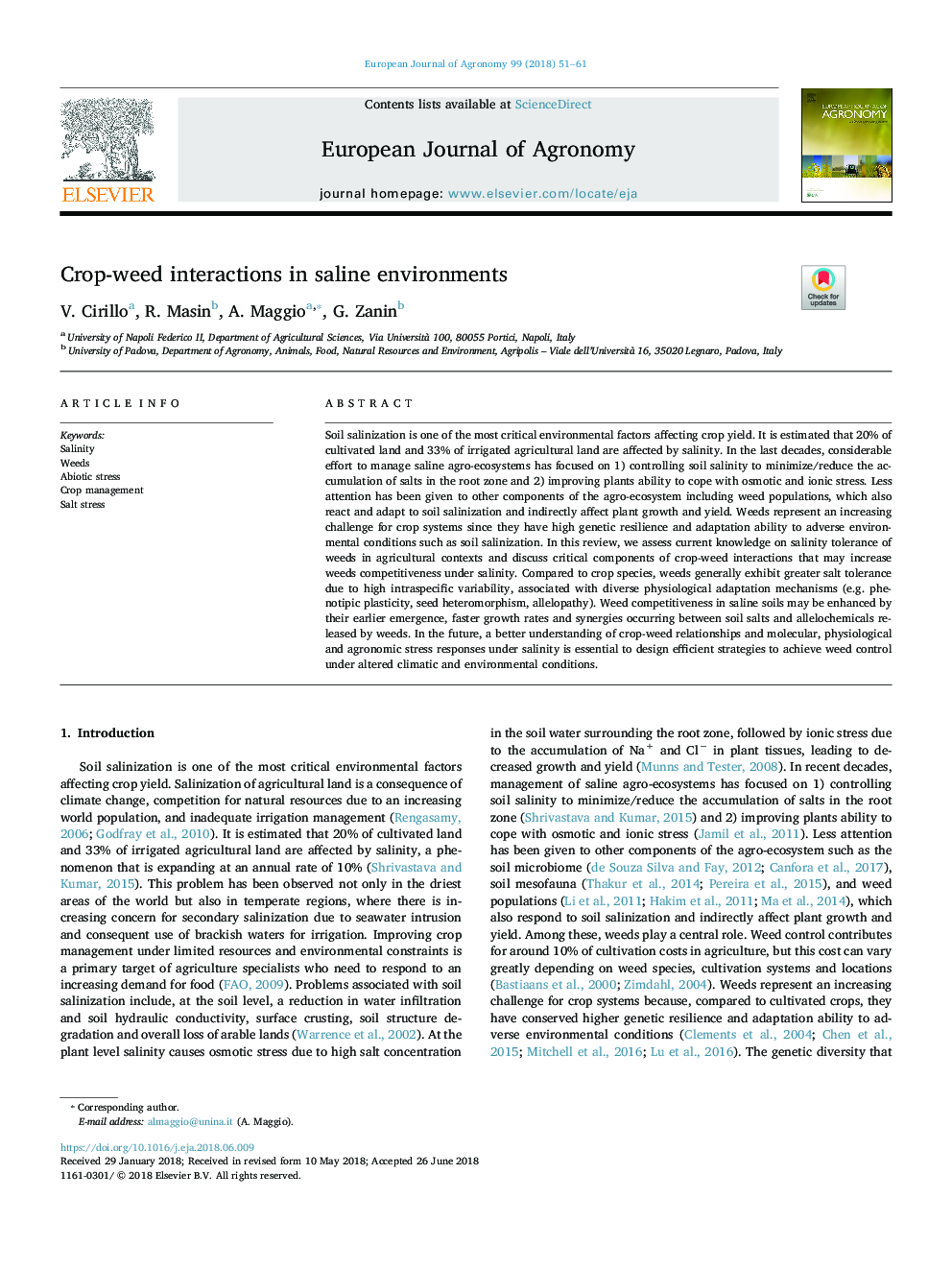| کد مقاله | کد نشریه | سال انتشار | مقاله انگلیسی | نسخه تمام متن |
|---|---|---|---|---|
| 8878819 | 1624425 | 2018 | 11 صفحه PDF | دانلود رایگان |
عنوان انگلیسی مقاله ISI
Crop-weed interactions in saline environments
ترجمه فارسی عنوان
تعامل علف های هرز در محیط های
دانلود مقاله + سفارش ترجمه
دانلود مقاله ISI انگلیسی
رایگان برای ایرانیان
کلمات کلیدی
شوری علف های هرز استرس بی روح، مدیریت محصول، استرس نمک،
ترجمه چکیده
سالینیزاسیون خاک یکی از مهمترین عوامل محیطی موثر بر عملکرد محصول می باشد. برآورد شده است که 20 درصد از زمین های کشت شده و 33 درصد از زمین های کشاورزی آبی تحت تاثیر شوری قرار دارند. در دهه های گذشته تلاش های قابل توجهی برای مدیریت زیست-محیط زیست شور در تمرکز بر روی 1) کنترل شوری خاک برای به حداقل رساندن / کاهش انباشت نمک در منطقه ریشه و 2) بهبود توانایی گیاهان برای مقابله با استرس اسمز و یونی. کمتر توجه به سایر اجزای اکوسیستم کشاورزی، از جمله علف های هرز، که همچنین واکنش و سازگاری با سالینیه خاک و به طور غیر مستقیم بر رشد و عملکرد گیاه تاثیر می گذارد، داده شده است. علف های هرز یک چالش بزرگ برای سیستم های محصول می باشد، زیرا آنها دارای انعطاف پذیری ژنتیکی بالا و توانایی سازگاری با شرایط محیطی نامطلوب مانند شور شدن خاک می باشند. در این بررسی، ما برآورد دانش فعلی نسبت به تحمل شوری علف های هرز در زمینه های کشاورزی و بحث در مورد اجزای مهم تعاملات علف های هرز می تواند سبب افزایش رقابت علف های هرز بر اساس شوری شود. در مقایسه با گونه های محصول، علف های هرز عمدتا تحمل به نمک زیاد را به دلیل تغییرات درونی درون گونه ای، همراه با مکانیسم های مختلف سازگاری فیزیولوژیکی (مثلا پلاستیک فنوتیپی، هترومورفیسم بذر، آللوپاتی) نشان می دهند. رقابت علف های هرز در خاک شور ممکن است با ظهور زودتر آن، سرعت رشد سریعتر و هم افزایی بین نمک خاک و آللوئیک شیمیایی منتشر شده توسط علف های هرز افزایش یابد. در آینده، درک بهتر روابط علف های هرز و پاسخ های استرس مولکولی، فیزیولوژیکی و زراعی تحت شوری، برای طراحی استراتژی کارآمد برای رسیدن به کنترل علف های هرز در شرایط آب و هوایی و محیطی ضروری است.
موضوعات مرتبط
علوم زیستی و بیوفناوری
علوم کشاورزی و بیولوژیک
علوم زراعت و اصلاح نباتات
چکیده انگلیسی
Soil salinization is one of the most critical environmental factors affecting crop yield. It is estimated that 20% of cultivated land and 33% of irrigated agricultural land are affected by salinity. In the last decades, considerable effort to manage saline agro-ecosystems has focused on 1) controlling soil salinity to minimize/reduce the accumulation of salts in the root zone and 2) improving plants ability to cope with osmotic and ionic stress. Less attention has been given to other components of the agro-ecosystem including weed populations, which also react and adapt to soil salinization and indirectly affect plant growth and yield. Weeds represent an increasing challenge for crop systems since they have high genetic resilience and adaptation ability to adverse environmental conditions such as soil salinization. In this review, we assess current knowledge on salinity tolerance of weeds in agricultural contexts and discuss critical components of crop-weed interactions that may increase weeds competitiveness under salinity. Compared to crop species, weeds generally exhibit greater salt tolerance due to high intraspecific variability, associated with diverse physiological adaptation mechanisms (e.g. phenotipic plasticity, seed heteromorphism, allelopathy). Weed competitiveness in saline soils may be enhanced by their earlier emergence, faster growth rates and synergies occurring between soil salts and allelochemicals released by weeds. In the future, a better understanding of crop-weed relationships and molecular, physiological and agronomic stress responses under salinity is essential to design efficient strategies to achieve weed control under altered climatic and environmental conditions.
ناشر
Database: Elsevier - ScienceDirect (ساینس دایرکت)
Journal: European Journal of Agronomy - Volume 99, September 2018, Pages 51-61
Journal: European Journal of Agronomy - Volume 99, September 2018, Pages 51-61
نویسندگان
V. Cirillo, R. Masin, A. Maggio, G. Zanin,
